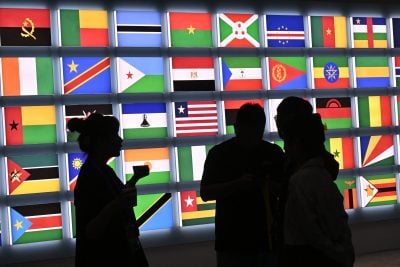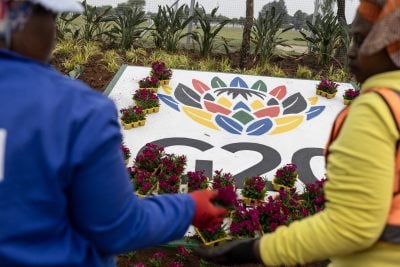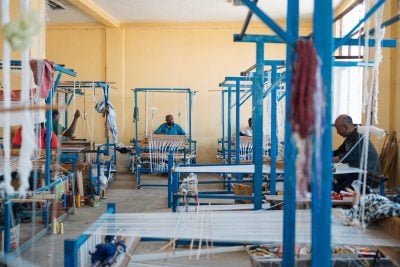Shifts in geopolitical alliances are rising up the agenda as US rivalry with China intensifies amid the fallout of Russia’s February 2022 invasion of Ukraine. Daily, diplomatic dramas grab our attention. Behind these developments are quieter initiatives that could have much greater impact in the long run: a series of moves by the BRICS bloc of countries – Brazil, Russia, India, China and South Africa – to challenge the dominance of the US dollar.
The headlines are dramatic. On 11 May Reuben Brigety, the United States ambassador to South Africa, sensationally accused his hosts of surreptitiously supplying weapons and ammunition to Russia for its war in Ukraine. Brigety says the arms were secretly loaded onto a Russian cargo ship at the Simon’s Town naval base in December.
Diplomatic fallout
The diplomatic fallout included a blanket denial by Pretoria, the announcement of an inquiry, a dressing-down for Brigety, and an apology in which he conspicuously did not retract his claim. It plunged the two countries to arguably their lowest point in relations since the end of apartheid.
This rift came as little surprise to those who have watched the tortuous direction of relations between the two countries since the beginning of the Russia-Ukraine War in early 2022. Since Putin’s troops poured across the Ukrainian border, South Africa has attempted to walk a diplomatic tight-rope, insisting on its neutrality and willingness to act as an impartial mediator in the war, while further building on historic relations with Russia which date back to the anti-apartheid era.
In the vein of “neutrality”, on 17 May South African President Cyril Ramaphosa declared that presidents Putin of Russia and Zelensky of Ukraine had given him the go-ahead to “commence the preparations” for an African peace mission to Europe. He would visit Moscow and Kyiv, alongside the leaders of Zambia, Senegal, Republic of Congo, Uganda and Egypt, on a date to be announced.
To date, South African “neutrality” has meant abstaining on UN resolutions criticising Russia and hosting joint naval exercises with Russia and China. This has prompted disquiet in the US and other western capitals that have long seen democratic South Africa as a valuable partner on the continent.
Come August, questions over South Africa’s geopolitical orientation will again return to centre stage when BRICS leaders convene in Durban for their fifteenth summit. This too promises diplomatic drama: South Africa is obliged under both international and domestic law to arrest Putin and hand him over to the International Criminal Court if he decides to attend. On 17 March the ICC issued an arrest warrant for Putin over the transfer of thousands of Ukrainian children from areas controlled by Russia, in violation of the Fourth Geneva Convention.
Related articles
- Should South Africa arrest Putin at the BRICS Summit?
- US accuses SA of arms sales to Russia – trade relations under threat
- Africa caught in a geopolitics bind
Moving to money matters…
The BRICS leaders would prefer the summit to be known as a key milestone in their efforts to move away from the Western-dominated world order that has reigned since the end of the Second World War – and to embrace a more diverse and representative global economic system.
Alongside the fallout of the Russia-Ukraine war, no issue looms larger for the BRICS than the hegemonic role of the US dollar as the global reserve currency. The dollar’s influence was crystalised with the establishment of the Bretton Woods institutions – the International Monetary Fund (IMF) and the World Bank – in Washington DC in 1944.
Proponents of an alternative reserve currency argue that in a multipolar world, driven by the extraordinary economic emergence of China, the dominance of the US dollar is a throwback to a more unequal time. “For too long a dollar-centric world has been out of sync with a multipolar trade world or real economy. The world has become more multipolar and that is a good thing, because pockets of the world have indeed prospered and graduated from poverty,” says Stephen Jen, CEO of London-based hedge fund Eurizon SLJ Capital.
Former South African President Thabo Mbeki stated in April that many countries are contemplating alternatives to the dollar to avoid the impact of US sanctions – a historic shift in perspective that is driven by a global desire not to be subjected to US power through its currency.
Recent economic shifts have heightened criticism around the dollar’s role. The US Federal Reserve’s moves to increase interest rates to tame inflation in the wake of Covid-19 and the Russia-Ukraine War have led to the dollar strengthening against emerging market currencies.
This means double trouble for economies in the Global South that hold and acquire dollar-denominated debt. Higher US interest rates tend to increase the relative value of the dollar on foreign exchange markets. So the cost of their debts rises, since more local currency is needed to repay each dollar of debt. This traps countries in a loop of financial obligation.
The hostages are restive
“The world has continued to rely on the dollar and been held hostage by the Fed’s policies. Emerging market countries have had to raise their interest rates to the mid-teens partly because they have had to work extra hard just to keep capital from fleeing. A unipolar currency world is not consistent with a multipolar real economy, and an erosion in the dollar’s reserve currency status, I think, is the first step in the right direction,” Jen says.
There are tentative signs that this decoupling is already taking place. According to the International Monetary Fund’s Currency Composition of Official Foreign Exchange Reserves (COFER) data, the dollar’s slice of global reserves has contracted: while still the majority, it has fallen from 66% in 2003 to around 58% in recent years.
Eurizon SLJ Capital’s analysis of the COFER data in real terms reveals a steeper ditching of the dollar. It indicates a precipitous drop from 55% of world reserves in 2021 to 47% in 2022.
Will the BRICS meeting accelerate the trend? The dollar’s monumental role in the global economy far outstrips the US’s own contribution to global export trade, which is a mere tenth of the world’s total.
Yet according to the Bank for International Settlements (BIS), about half of all international trade transactions are invoiced in US dollars, highlighting the currency’s disproportionate influence. “It’s a matter we must discuss and discuss properly,” South African minister of international relations and cooperation Naledi Pandor told Bloomberg.
Chucking BRICS at the dollar
The most headline-grabbing initiative to challenge the dollar is the suggestion of a common currency for the BRICS bloc. Like the African peace mission, this has been floated by Russia and taken up by South Africa. This, though, would be a long way off. More immediate moves to dilute the dollar’s hegemony could include extending the power of the New Development Bank (NDB) and bilateral deals; promoting an alternative to the SWIFT payment-clearance system; leveraging BRICS countries’ gold holdings and production; and moving into digital currencies.
Advocates believe a new currency could streamline transactions, currently bogged down by currency conversion and related costs, bolstering economic integration in the bloc. With the bloc registering a trade surplus of $387bn in 2022, accumulating substantial gold reserves, and accounting for 40% of the world’s population and a third of global economic output, greater merging of the bloc under the umbrella of a new currency could mean a gradual decline in the dominance of the dollar.
While the form of such a currency is unknown, Joseph Sullivan, a senior adviser at the Lindsey Group and former White House economist, says that the proposed “bric” could be tied to a basket of the constituent BRICS currencies: the Brazilian real, Russian ruble, Indian rupee, Chinese renminbi, and South African rand: it could be a “rrrrr”. Its worth would sway according to shifts in these currencies’ values.
Zongyuan Zoe Liu – a fellow at the Council on Foreign Relations and co-author of the study Can BRICS De-dollarize the Global Financial System? – believes it likely that a non-binding joint statement from the BRICS bloc will be released during August’s summit, indicating plans to explore a new currency’s feasibility and potential pilot projects.
But the new currency’s success would rest on its stability, widespread adoption, and ability to offer an enticing alternative to established currencies. Furthermore, aligning the distinct economic policies and objectives of each BRICS nation would be a daunting task.
A formal endorsement of a BRICS currency may be some way off. Pandor warned against assuming that “the idea will work, because economics is very difficult and you have to have regard to all countries, especially in a situation of low growth when you are emerging from crises”.
Bilateralism at work
Plans to reduce the dollar’s influence in other ways have moved beyond the discussion stage. Some BRICS nations have already implemented a series of bilateral currency swaps to augment the use of local currencies in trade and bypass the greenback, deepening de-dollarisation pathways, says Liu. China has signed agreements with both Russia and Brazil to drop the US dollar in trade.
Such bilateral trades are risky. If either currency fluctuates too much, one party will lose value on delivery day. Still, there is likely to be a proliferation of currency swap arrangements between African central banks and China’s central bank, says Eswar Prasad, senior fellow at the Brookings Institution and author of The Future of Money. These would reflect and reinforce the increasing power of the remnimbi as China increases its economic and diplomatic footprint in Africa.
“Access to renminbi liquidity is attractive for countries that have strong trade and financial linkages with China. Such deals become increasingly attractive as the renminbi gradually becomes a more important international currency,” Prasad says.
Other efforts are underway at New Development Bank (NDB), the multilateral bank established by the BRICS states, to effect change. The NDB’s local currency lending program has started to chisel away, albeit slightly, at BRICS countries’ dependence on dollar development financing. This comes as global financial institutions such as the IMF, World Bank and European Central Bank recalibrate their focus towards the Global South, in part to counterbalance China’s strategic loan programs in Africa.
Enhancing the NDB’s strategy is its AA+ credit rating from S&P Global Ratings. This enables the bank to raise capital at a cheaper rate and lend at lower rates than the BRICS members’ banks could individually. This combined approach – promoting local currency lending and moving away from dollar-dominated funding – forms a cogent challenge to the dollar’s long-standing hegemony in global development finance.
South Africa, for example, plans to seek further loans from the NDB for the 2023/24 fiscal year, as it addresses the challenges faced by its energy sector. A previous NDB loan in 2019 funded a Battery Energy Storage System to meet peak electricity demand with electricity from renewables. The new NDB loan is anticipated to strengthen the transmission system, especially in wind-rich and solar-rich provinces — and to improve the lacklustre performance of South Africa’s renewable energy drive.
Promoting payment paths
Another pathway BRICS nations are exploring in their quest for de-dollarisation is the development of their own global payment systems. By doing so, they aim to reduce dependence on the US dollar and on SWIFT, the dominant global payment network.
This move could also allow them to set their own international banking rules, and would help insulate them from US sanctions. Russia and China are developing their national alternatives to SWIFT.
And it is not only through the medium of BRICS or a rising China that African countries are considering their options for currency improvements.
The Pan-African Payment and Settlement System (PAPSS), an initiative developed by Afreximbank, aims to transform intra-African trade by facilitating cross-border transactions in local currencies. Projected to save Africa $5bn annually in transaction costs, it dovetails with the immense potential of the African Continental Free Trade Area (AfCFTA) to enable Africa’s economic self-sufficiency and growth.
Carlos Lopes, professor at the University of Cape Town, and former executive secretary of the UN Economic Commission for Africa, says that the system embodies a significant stride towards de-dollarising Africa, mitigating the continent’s dependency on external financial systems.
“If you don’t want to fall in the lap of the Chinese, you would like to have economic governance standards that protect you. African governments are navigating the geopolitical tensions as much as they can, because right now, it’s about cutting through the fact that you must have a third party in the process of payments that keeps much of the value,” Lopes says.
Go for gold
Central banks from the Global South and the Middle East are also strategically transitioning towards bolstering their gold holdings as part of their diversification play.
Gold demand reached a decade high in 2022, driven by significant central bank purchases and highlighting the asset’s appeal amid geopolitical uncertainties. The World Gold Council (WGC) reports an 18% increase in annual gold demand last year to 4,741 tonnes. This is the largest amount since 2011 – and central bank purchases have hit a 55-year high. This is largely attributed to central banks diversifying reserves away from the dollar, particularly after US asset freezes, which caused jitters from Beijing to Buenos Aires.
Taiwo Oyedele, fiscal policy partner and Africa tax leader at PwC, suggests a potential shift in currency strategies. “There is a possibility that a few African countries, especially South Africa as part of BRICS, may consider re-evaluating their currency reserve strategies.”
There is, though, currently no concrete plan indicating that reserve managers are taking such steps this quarter, Oyedele says. Instead, they appear to be in a holding pattern, observing the unfolding global dynamics, particularly the power struggle between the West and a rising China and its allies.
Digital dreams
At its foundations, the de-dollarisation process is being driven by demographic changes, carbon accounting, and the rise of Central Bank Digital Currencies (CBDCs), Lopes argues.
In Africa, the digital currency landscape is evolving rapidly, its pace set by nations like Nigeria, Kenya, and South Africa, which have embraced these advances and are spearheading regulatory initiatives. Proponents argue that CBDCs are emerging as not merely novel monetary tools, but as beacons of financial inclusivity, lighting up the pathway for millions to enter the digital economy.
As Nigeria fine-tunes its eNaira following a popular backlash, and South Africa advances with its wholesale CBDC tests, the continent is carving out a unique space in the global financial architecture.
“We are going to look into it as the beginning of the marriage of a new financial governance with technology,” says Lopes.
The transition to digital currencies is poised to undercut the traditional monetary hegemony, heralding an era where Africa asserts its digital economic sovereignty.
This growing assertiveness, combined with the BRICS’ swelling clout on the global stage and willingness to recruit new members, could signify a potential recalibration of global power dynamics, posing a formidable challenge to the long-held US hegemony and the G7’s established economic order.
There’s still the ‘prettiest pig in the pigpen’
But attempts to sever deep-rooted ties with the dollar may not prove equally attractive for all BRICS members, and any transition promises to be a slow and complex process.
“The BRICS members have shown a strong commitment to promoting the use of local currencies, to build non-dollar alternatives to international financing,” says Liu. “But for countries like South Africa, as well as other major African economies, they are still commodity-based. And whether it is timber, or critical minerals or oil, these goods are priced in dollars in world markets, so their economies are deeply exposed to the dollar-based financial system, and using domestic currency to raise debt is going to be extremely difficult due to the lack of developed local debt markets.”
Advocates of the dollar say that, despite its inherent imperfections, it has consistently served as a haven for investments. Its vast, comparatively safe, and less corrupt market makes it the “prettiest pig in the pig pen,” says David Beckworth, a research fellow at George Mason University’s Mercatus Center.
The dollar’s allure was especially pronounced during the recent global economic crisis. Such was the international demand for the greenback that the Federal Reserve was compelled to launch a daily swap program with other central banks. This move, many western analysts say, will reinforce the global dollar system, and magnify its already extensive network effects.
“On the one hand, the US government is pushing some people away because it overuses final sanctions. But at the same time, the other hand of the US government, the Federal Reserve, is doing all it can to reassure global investors that the dollar is a safe place to hold assets. And I think the Fed’s efforts are stronger than what the Treasury Department is doing regarding international sanctions,” Beckworth says.
This implies that without a catastrophic event, such as a ruinous banking crisis, internal political collapse, or a Chinese invasion of Taiwan leading to a global war, the dollar’s inherent first-mover advantage is unlikely to falter in the short term.
China, the world’s second-largest economy, is leading the charge. In 2022 the Chinese renminbi continued to rise steadily, in line with the pace seen in recent years, as Beijing reduced its US treasury bond holdings by around 20%. But some of the weaknesses in China’s capital controls and governance systems mean that the dollar will continue to prove attractive to investors, say analysts.
Emerging Market reserve managers “are certainly eager to diversify away from investments in countries and currencies perceived as being on the other side of deepening geopolitical fissures,” says Prasad.
“The difficult reality that reserve managers face, however, is that the supply of financial assets that are easy to buy and sell cheaply and in large quantities – and that are backed up by strong central banks and regulatory frameworks – comes primarily from the large, advanced economies. The renminbi’s share in emerging market economies’ reserve holdings will undoubtedly increase on account of diversification motives and geopolitical tensions, although this increase will be constrained by China’s capital controls and weak institutional framework,” Prasad says.
The young continent
The Western world, facing population decline, stands juxtaposed against a burgeoning Africa, teeming with a youthful, increasingly tech-savvy demographic. The implications of this dichotomy, Lopes suggests, will echo through global financial structures, eroding the current dominance of the dollar, and reshaping the economic narrative.
Whether or not predictions of the demise of the dollar will prove premature, this August represents an important milestone.
Africa, thoroughly disregarded during the establishment of the dollar’s Bretton Woods world order in the aftermath of post-WWII, will finally take centre stage.
Want to continue reading? Subscribe today.
You've read all your free articles for this month! Subscribe now to enjoy full access to our content.
Digital Monthly
£8.00 / month
Receive full unlimited access to our articles, opinions, podcasts and more.
Digital Yearly
£70.00 / year
Our best value offer - save £26 and gain access to all of our digital content for an entire year!

 Sign in with Google
Sign in with Google 



